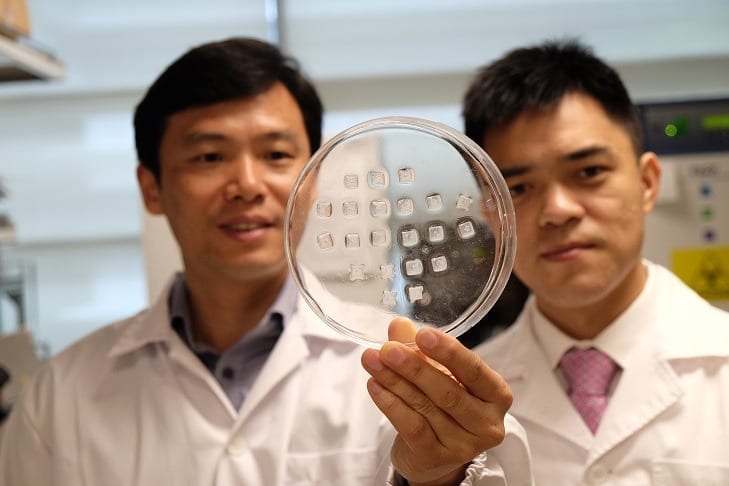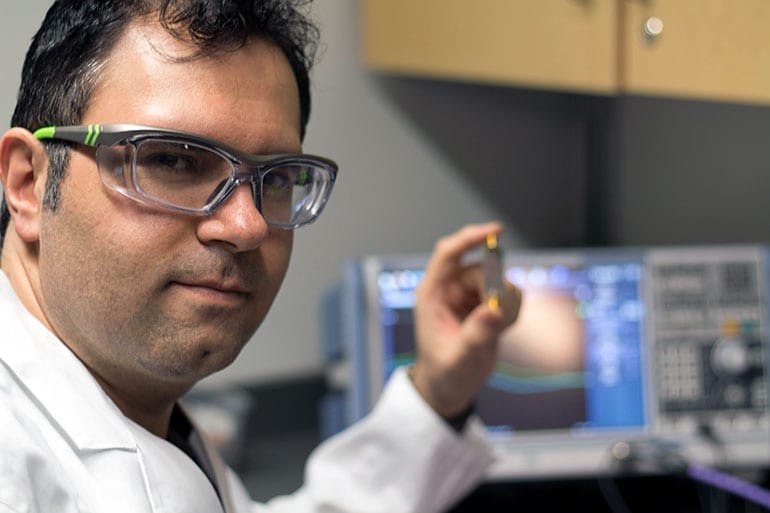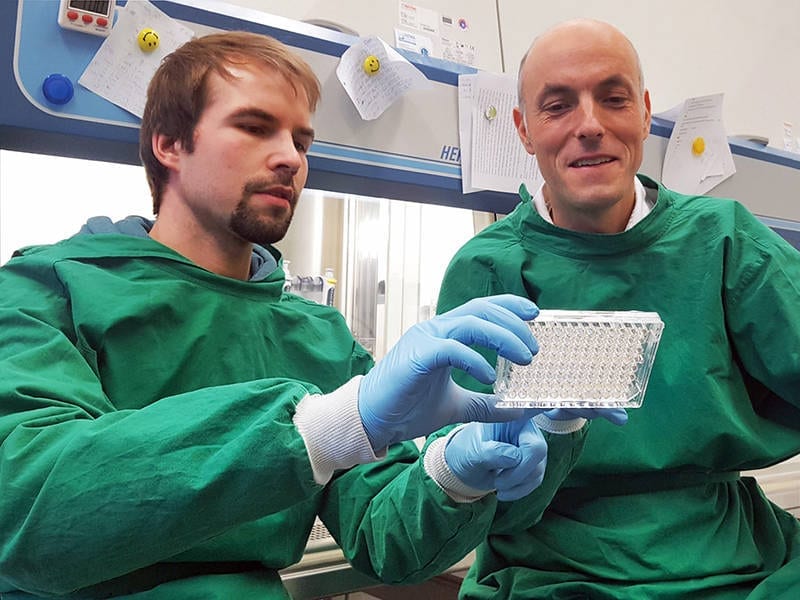
A new approach to reducing bulging tummy fats has shown promise in laboratory trials
It combines a new way to deliver drugs, via a micro-needle patch, with drugs that are known to turn energy-storing white fat into energy-burning brown fat. This innovative approach developed by scientists from Nanyang Technological University, Singapore (NTU Singapore) reduced weight gain in mice on a high fat diet and their fat mass by more than 30 per cent over four weeks.
The new type of skin patch contains hundreds of micro-needles, each thinner than a human hair, which are loaded with the drug Beta-3 adrenergic receptor agonist or another drug called thyroid hormone T3 triiodothyronine.
When the patch is pressed into the skin for about two minutes, these micro-needles become embedded in the skin and detach from the patch, which can then be removed.
As the needles degrade, the drug molecules then slowly diffuse to the energy-storing white fat underneath the skin layer, turning them into energy-burning brown fats.
Brown fats are found in babies and they help to keep the baby warm by burning energy. As humans grow older, the amount of brown fats lessens and is replaced with visceral white fats.
Published in the journal Small Methods recently by NTU Professor Chen Peng and Assistant Professor Xu Chenjie, this approach could help to address the worldwide obesity problem without resorting to surgical operations or oral medication which could require large dosages and could have serious side effects.
“With the embedded microneedles in the skin of the mice, the surrounding fats started browning in five days, which helped to increase the energy expenditure of the mice, leading to a reduction in body fat gain,” said Asst Prof Xu, who focuses on research in drug delivery systems.
“The amount of drugs we used in the patch is much less than those used in oral medication or an injected dose. This lowers the drug ingredient costs while our slow-release design minimises its side effects,” said Asst Prof Xu.
Obesity which results from an excessive accumulation of fat is a major health risk factor for various diseases, including heart disease, stroke and type-2 diabetes. The World Health Organisation estimates that 1.9 billion adults in the world are overweight in 2016 with 650 million of them being obese.
“What we aim to develop is a painless patch that everyone could use easily, is unobtrusive and yet affordable,” said Prof Chen, a biotechnology expert who researches on obesity. “Most importantly, our solution aims to use a person’s own body fats to burn more energy, which is a natural process in babies.”
Under the two scientists’ guidance at NTU’s School of Chemical and Biomedical Engineering, research fellow Dr Aung Than conducted experiments which showed that the patch could suppress weight gain in mice that were fed a high fat diet and reduce their fat mass by over 30 per cent, over a period of four weeks.
The treated mice also had significantly lower blood cholesterol and fatty acids levels compared to the untreated mice.
Being able to deliver the drug directly to the site of action is a major reason why it is less likely to have side effects than orally delivered medication.
The team estimates that their prototype patch had a material cost of about S$5 (US$3.50) to make, which contains beta-3 adrenergic receptor agonist combined with Hyaluronic acid, a substance naturally found in the human body and commonly used in products like skin moisturisers.
Beta-3 adrenergic receptor agonist is a drug approved by the Federal Drug Administration of the United States and is used to treat overactive bladders, while T3 triiodothyronine is a thyroid hormone commonly used for medication for an underactive thyroid gland.
Both have been shown in other research studies to be able to turn white fats brown, but their use in reducing weight gain is hampered by potentially serious side-effects and drug accumulation in non-targeted tissues if conventional drug delivery routes were used, such as through oral intake.
NTU’s Lee Kong Chian School of Medicine Associate Professor Melvin Leow, who was not affiliated with this study, said it is exciting to be able to tackle obesity via the browning of white fat, and the results were promising.
“These data should encourage Phase I Clinical studies in humans to translate these basic science findings to the bedside, with the hope that these microneedle patches may be developed into an established cost-effective modality for the prevention or treatment of obesity in the near future,” added Assoc Prof Leow, an endocrinologist.
Since the publication of the paper, the team has received keen interest from biotechnology companies and is looking to partner clinician scientists to further their research.
Learn more: New patch aims to turn energy-storing fats into energy-burning fats
The Latest on: Microneedle fat burning patch
[google_news title=”” keyword=”microneedle fat burning patch” num_posts=”10″ blurb_length=”0″ show_thumb=”left”]
via Google News
The Latest on: Microneedle fat burning patch
- Fat-burning workoutson May 1, 2024 at 5:00 pm
Losing fat, but these five steps will get you on the right track to success. Here's how to burn fat and build muscle. How can you lose belly fat fast? Try our 4 week workout plan to lose the ...
- microneedle patchon April 30, 2024 at 5:00 pm
This is the promise of microneedle patches (MNP), which are essentially what they sound like. These would also have uses in diagnostics that might one day obliviate the need for drawing blood.
- Patch to protect against measles in children shows promiseon April 30, 2024 at 12:23 pm
A young child in The Gambia has a microarray patch applied to the wrist, to vaccinate him against measles A vaccine patch could be a safe and effective alternative way to protect young children ...
- CD Formulation Unveils Hydrogel Microneedle Patch Technology to Increase Drug Loading Capacityon April 12, 2024 at 5:00 pm
CD Formulation, a leading pharmaceutical contract service company, has recently unveiled groundbreaking hydrogel microneedle patch technology aiming at increase the drug loading capacity and enhance ...
- 5 Workouts That Burn the Most Faton December 5, 2023 at 3:30 am
Embarking on a journey to shed excess fat demands a strategic approach to your workouts. While numerous exercise routines claim to burn fat effectively, not all are created equal. For my clients ...
- How to find your fat-burning zoneon September 20, 2023 at 5:40 am
If you want to burn as much body fat as possible while you exercise, ignore the charts at your gym showing generic “fat-burning zones.” Instead, try these do-it-yourself hacks to learn how to ...
- A Microneedle Vaccine Patch Printer For Thermostable MRNA Vaccineson April 30, 2023 at 6:12 am
This is the promise of microneedle patches (MNP), which are essentially what they sound like. These would also have uses in diagnostics that might one day obliviate the need for drawing blood.
- Microneedle Patch Speeds Plant Disease Detection (IMAGE)on July 31, 2021 at 9:48 am
Caption Researchers have developed a new technique that uses microneedle patches to collect DNA from plant tissues in one minute, rather than the hours needed for conventional techniques. DNA ...
- Can Coffee Really Help You Burn Fat? What This Study Saidon June 24, 2019 at 10:51 pm
Saying that "coffee can help you burn fat" sounds a lot more compelling than "caffeine can promote BAT function at thermoneutrality," where BAT stands for "brown adipose tissue" and has nothing to ...
via Bing News










